Lek
an aggregation of males that gather to engage in competitive displays that may entice visiting females who are surveying prospective partners for copulation. this mating system may have evolved in certain species if males cannot defend widely dispersed food resources or dynamic and temporary herds. Males all right in one area not have to defend multiple areas or their own, come together.
Lek Benefits
Main for both sexes: Mating success
Males: not have to put any resources in defending their own area
Cost for Males: traits that females prefer may be energentically expensive to maintain. - females judge right on the spot
Females: search time for a suitable mate is reduced, watch the fights and find the one they want, 1 spot
Many large mammal herbivores form seperate herds for each sex: male only or female only, what are the benefits?
M: not spend all their time and energy impressing females, but spend time eating and stocking up. Waste time on display and not eat enough
F: risk competing males killing their young. juvenile fitness driven, males want to kill preexisting babbies bc not their genes and want the females to have their babies so not worry about killing young
Coloration of animals gives you a hint to their habitats. Describe
Colors help with camoflauge
Lighter: grassland habitats. Blend into surroundings so harder for predators to spot- sandy area
Dark: Bongo, w/ undulating stripes, useful for camofloge in dark/forest habitats, occasional bands of light penetrating the canopy- wooded rocky
Structural modifications in the skulls of animals that use their heads as weapons?
animals that use their heads as weapons have: Convoluted structures, which increased bone strength in the skull.
Males tend to have thicker skulls bc use as high impact weapons
Ungulates are...
Herbivores
polygynandrous
meaning that numerous matings can occur in a season between many partners
Antlers
Not present in both sexes
Shed Annually
Used in Male Combat
Are Branched
Bone Core w/ skin sheath
Pronghorn
Present in both sexes
Partially Shed Annually
Used in Male Combat
Are Branched- in Males
Bone Core w/ Keratin sheath
Horns
Present in both sexes
Not Shed Annually
Used in Male Combat
Are NOT Branched
Bone Core w/ Keratin sheath
parasigittal
limb posture: limbs positioned directed underneath the bodies
What are purposes of museums?
1-public education through the display of specimens
2- education and research through the collection and preservation of specimens for reference and study
What is a Fossil?
a fossil is any trace of past life preserved in rock, 2 kinds
Body Fossil
Trace Fossil
B:preserved parts of the bodies of organisms, such as bones, leaves, etc
T:include a wide range of traces left behind by living organisms, such as footprints, casts of burrows, or coprolites= fossilized feces= doesn’t preserve an actual part of the organism
For an organism to be fossilized it must be buried by...
The hard parts of organisms (like vertebrate bones and teeth) tend to fossilize best...
Whole bodies of organisms sometimes fossilize intact and together, but it is common for ...
sediments (sedimentary rocks)
often they are turned to stone through the replacement of minerals brought in by groundwater.
Occasionally, traces of soft parts may also be preserved before they decay.
animal carcasses to fall apart before they are buried, so many fossils only include partial skeletons, or even only isolated bones and teeth
Geolotical Time Scale GTS
units are/are not equal in durations... based on ___ distincitons
yonger are top/bottom of older?
describe the relative ages of rock beds and the fossils within them, based on the positions of rock layers with respect to each other and absolute, radiometric dates for key rock beds
breaks up time into a hierarchy of sequentially named units. These are not equal in duration, but instead are based on major distinctions between rock units
(younger rocks are originally deposited on top of older ones)
Broadest names section.. broken into.. broken into...
boundaries between these sections of time are demarcated by ___in the geologic record – for instance, the boundary between the Cretaceous and Tertiary Periods (the same as the boundary between the Mesozoic and Cenozoic Eras) is marked by the major extinction event that killed off most dinosaurs
era
period
Epochs
major events
What Can We Learn from Fossils?
structure of organisms that lived in the past.
interpret patterns of evolutionary change through time= anatomical changes, species that lived in a particular region through time, or kinds of animals that lived on earth through processes of speciation and extinction
Vertabrate life began in ...
water
Ray-finned fishes are often preserved as whole skeletons, but usually the only fossil shark specimens found are teeth. Why do you think this is the case? (Hint: What do you remember that is different about the skeletons of sharks vs. ray-finned fishes?)
Ray= bone preserves
Shark: cartlidge not preserve
Fine- grain preservation better than large coarse bc...
different environments of animal fossil known?
big/corse conglomerate will pulverize any specimen: not well know fossil record of animal from environments
Fine: not cause damage allows bones to stay articulated: much better known animal fossil environment

Neusticosaurs edwardsi and Mesosaurus brasiliensis: short neck long tail, medium legs-- how did they swim
Crocidile moder semi-aquatic, swam using bodies more than limbs- body undulation

TIKTAALIK ROSEAE (CAST)
tetrapod
“large shallow-water fish”
fossil was found in sediments deposited in a shallow river channel (signifying an environmental transition to freshwater habitats from the marine habitats its ancestors inhabited)
Fish features
Scales covering body
fins w/ webbing
Early Tetrapod features
o Dorsoventrally flattened head with eyes on top (similar to crocodile heads)
o Has neck (seen for the first time in the fossil record! Allowed the head to move)
Tiktaalik was intermediate between fishes and tetrapods, so let’s look at just one more. Look closely at the forelimbs
limb bones in pectoral fins, bones/joints homologous to upper arm, wrist, elbow, and shoulder in tetrapods
swim w/ fins as paddles & prop up/ "push up" in shallow waters, sturdy fins support body to push along or stabalize itself in moving water
Teeth vs. Claws
teeth are covered by enamel (which preserves), but
claws are covered by the protein keratin (which doesn’t – only underlying bone is preserved)
T-rex closer related to herbivore duck billed dinasour or fossil hawk Buteo
Buteo! bc curved claws
trex meat eating
Pterosaurs were a group of flying reptiles that lived at the same time as dinosaurs (but were not dinosaurs themselves). The flying surface (airfoil) of the pterosaur wing was comprised of a long membrane of skin. In contrast, bird wings are comprised of feathers Archaeopteryx.
wing structure
Pt: v long digit support wing membrane
Arch: wing supported by entire arm as opposed ot 1 finger
bristle-like teeth on the lower jaw!! What does their structure indicate about how this pterosaur likely fed?
Filter feeter vert.
strain prey algea plankton small crustaceons
Horses live primarily in _____, but in the past, horses originated in forests and lived in a variety of habitats
Where (geographically) did horses originate as a lineage? Have horses continuously inhabited that region since their origin?
open grasslands
N/S america,
contin: eurasia & africa until reintroduce
As horses adapted to grassland environments, their legs became longer. In which region of the leg did bones grow longer – upper (proximal) leg, or lower (distal) leg? Why does it make sense that these grew longer instead of others?
distal/lower part grew longer bc lighter weight bones grow without increasing the mass too much, if femur would be too heavy/ energy to move
Modern horses all have a single functional toe on each leg. What habitats is this thought to have helped them to flourish in? If this represents an adaptive change, why, in the past, might three-toed horses have also been able to co-exist with single-toed horses?
1 toe- open grassland = running long distance over hard ground helped by light distal bones
3 toe- coexisted bc succeded in different habitats of the forests
group of reptiles that includes vertebrates such as dinosaurs (including birds) and crocodilians
archosaurs
archosaurs synapomorphies
1-mandibular (lower jaw) fenestra
2-most interesting evolutionary transitions in vertebrates: the evolution of flight. Flight has evolved in relatively few vertebrate groups (bats, birds and pterosaurs).
Ground up vs. Top Down
ground up ancestors of birds were small, ground-dwelling dinosaurs that would flap their feathered arms while running to generate lift. some birds will flap their wings in order to increase their speed and gain some lift. The top down theory birds’ feathered dinosaur ancestors were arboreal (moved around in trees), and then flew or glided down from the trees
Based on the evidence that the closest dinosaur relatives of birds ran on the ground, which theory (ground up or top down) is the most likely explanation for how flight evolved in birds?
ground up
closest dinasour relative liveed on ground, more likely evolved running and flapping
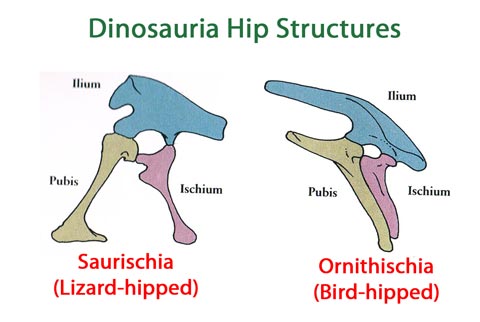
The evolution of archosaurs was associated with major morphological transformations, such as the orientation of the pubis. The pubis is a long, thin bone running along the anterior side of the pelvic girdle (see placard for illustration). How has the orientation of the pubis bone changed from the alligator (exhibiting the primitive condition) to the modern bird (exhibiting the derived condition)?
Primitive point forward- alligator
derived point backwards-- modern birds
“raptor prey restraint” (providing another line of evidence for their evolutionary relationship to birds), which involved pouncing on the prey and pinning it down with the Velociraptor’s body weight. What structure is present on the Velociraptor’s feet that could be used to hook onto the prey to prevent it from escaping?
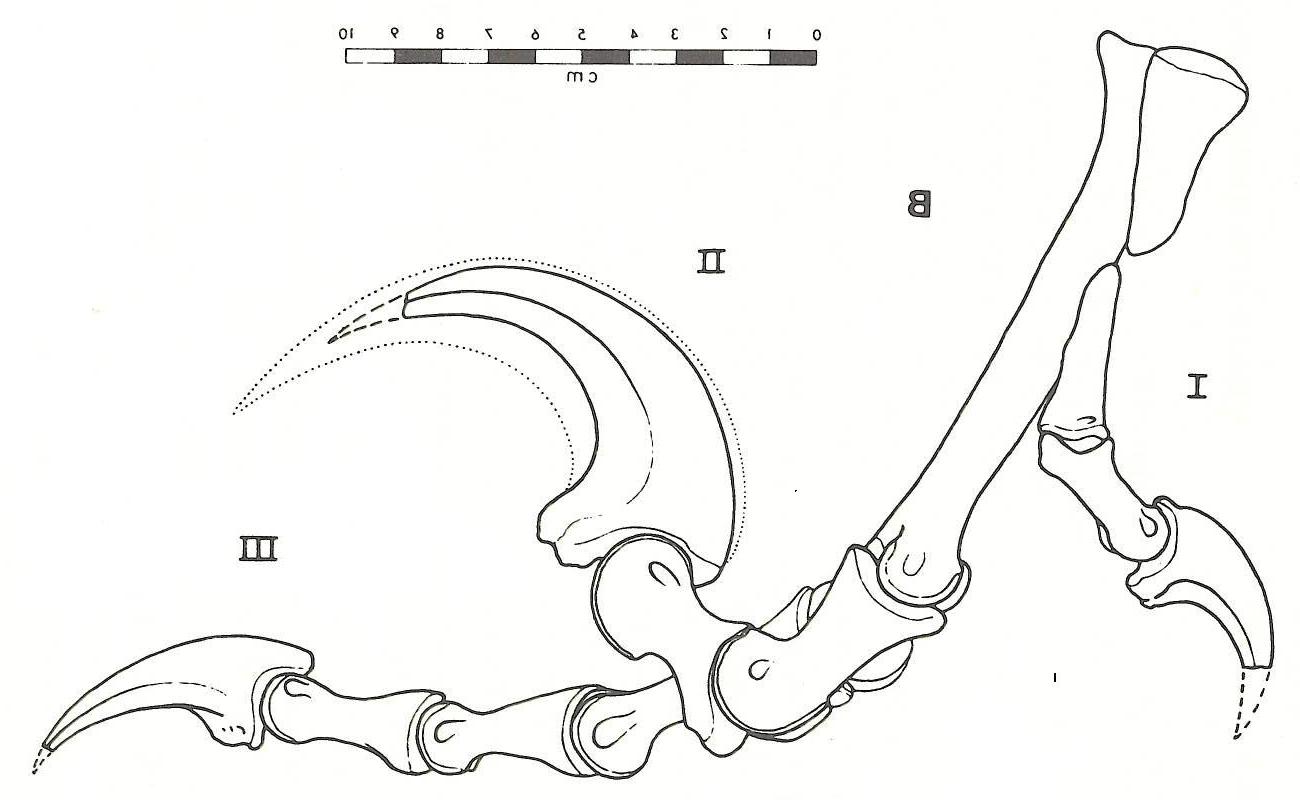
Sharp talons/ claws, but talon on 2nd digit is most useful sickle shaped enlarged and held off group during locomotion acta s a switchblade to attack and swing down dig into prey and prevent slip away
T. rex had a bipedal posture that resembled modern kangaroos, but research within the past few decades revealed that such a posture would not have been possible since it would have dislocated many of their joints! Instead, bipedal T. rex held its body more parallel to the ground (like the Velociraptor)
2 distingushing features
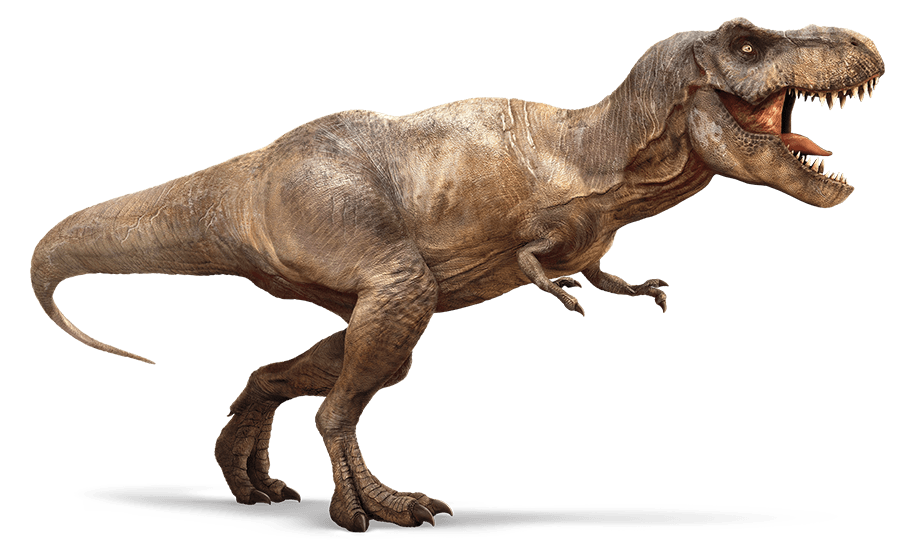
1-“key-hole” shaped lateral temporal fenestra. The diapsids, a major clade of reptiles that includes species like the tuatara, alligator, and also T. rex, have two holes in their head
2-back of the head is much wider than the tip of the snout.
Dimetrodon is another recognizable prehistoric vertebrate. However, contrary to popular belief, this animal is not a dinosaur! Rather, Dimetrodron is commonly called a “mammal-like reptile” and we will explore its relationships in a question below. The name “Dimetrodon” means “two measures of teeth”. If you observe the skull on the specimen here, you can see the large canine teeth in the anterior (front) portion of the jaw and smaller teeth in the posterior (rear) region of the jaw. Dimetrodon’s most distinctive feature is its dorsal sail, supported by elongated neural spines on the vertebrae

Diapsid
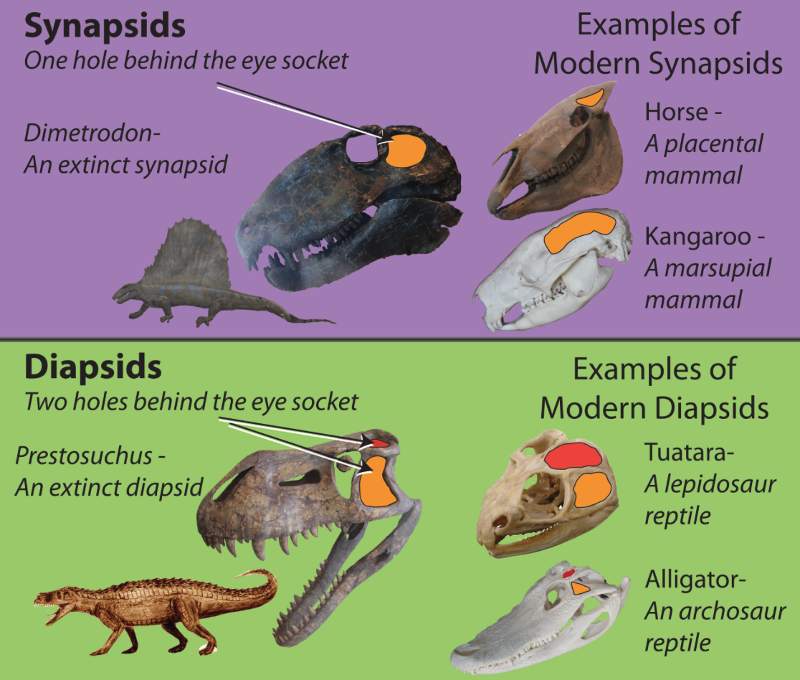
2 holes in head
major clade of reptiles
two holes in their head: one on the top of their head, and one on the side of their head (this is the lateral temporal fenestra)
-The diapsids had 2 holes behind the eye, and gave rise to modern groups like lizards and snakes, and the archosaurs (crocodilians and dinosaurs, including birds).
Synapsid
1 hole in head
mammals
1 hole in the head
Another group, called the synapsids, had only a single temporal fenestra behind the eye, and gave rise to modern groups like the mammals.
Morphological traits in the skull can help infer what type of vision animals had. For instance, vertebrates such as the modern hawk in Station 6 (and humans!) have binocular vision with eyes that tend to point forward, and skulls that are much wider at the back than at the front. On the other hand, animals that use monocular vision, like alligators and many fishes, tend to have eyes on the sides of their heads, and skulls that have a fairly uniform width. What type of vision (monocular or binocular) do you think T. rex had?
Binocular, width help hunting prey, both eyes corrdinating make single feild of vision, better death precise capture prey
mono- wider field, less detail further
temporal fenestrae (see notes for Station 8 above), help to distinguish two major clades of vertebrates.
-The number of holes in the side and top of one side of the skull (behind the eye)
Compare the number of temporal fenestrae in the skull of Dimetrodon to that of Tyrannosaurus. Based on this information, how would you classify each of these fossils (diapsid vs. synapsid)? Which is more closely related to mammals, including you?
Dimetro- synapsid= CLOSER to me
trex= diapsid
Compare the lower jaws of Smilodon and the tiger in lateral view (in the case near Smilodon). Examine the posterior region of the jaw. Which looks like it would have more forceful jaw closing? (Hint: what process do jaw-closing muscles attach to, and how does the size of this process differ between these jaws?)
controled by CORONOID process
smilidion- v small coronoid / tiger v large so more SA for muscle attachment longer lever jaw closing, greater mechanical advantage

Compare the skulls of the domestic dog (Bottom shelf, BCGM 10124) and the Dire Wolf (Top Right Shelf, BCGM 10130). How are they different, and how might these differences relate to their bite force (hint – look at the ridge at the top of the skull).
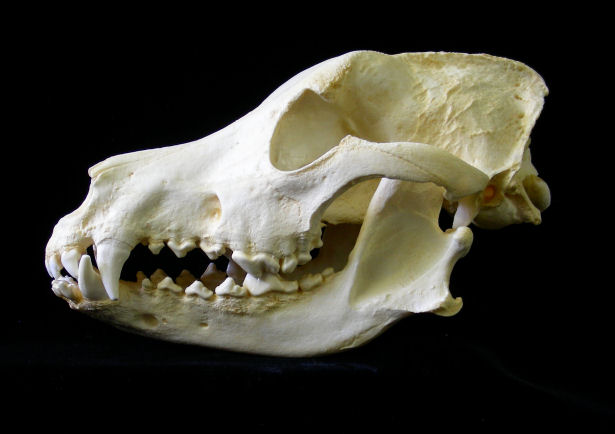
Wolf: larger ridge at top, more SA for muscle attachment, allows greater bite force larger jaw closing
coronoid
condyloid
angular
jaw closing
Amniotes, the sister clade of the amphibians. include all tetrapods that are not amphibians, and are united by 2 synapomorphies
- (1) The amniotic egg (also called cleidoic egg) - where the name amniote came from; this is an egg with membranes that surround the embryo (like, say, the amnion) which allow for cushioning, gas exchange, and waste removal.
- (2) The astragalus – a distinctive tarsal bone in the ankle (called the talus in humans for no very good reason) that forms from the fusion of several smaller tarsals and forms the hinge between your shin and your foot.
amniotic egg allowed....
the evolution of the amniotic egg allowed tetrapod lineages that possessed it to invade and live in a wider range of habitats than amphibians.
reptiles and mammals
astralugus

make the ankle joint more stable and might increase the range of locomotor behaviors or other limb functions in amniotes compared to amphibians. It is also important from a practical standpoint, because finding an astragalus in a fossil taxon would let us know that it was an amniote!!!!!!!!!!
amniotes 2 major clades
synapsids and reptiles (birds)
The skulls of reptiles show one of two patterns. The primitive condition is to have no holes posterior to the eye (except for the ear). This is called the anapsid condition (meaning “without holes”, Fig. 2B). Turtles were previously regarded as being the only extant anapsids, but recent studies suggest that turtles are actually diapsids that have secondarily closed their temporal fenestrae. The derived condition, found in essentially all living reptiles, is for the skull to possess two holes posterior to the eye – this is called the diapsid condition (meaning “two holes”, Fig. 2C). This is seen very clearly in crocodilians and tuataras. In lizards and snakes (and birds) the holes enlarge (much like in mammals), which makes them a little harder to find.
...
Turtles are united as a clade by several bizarre features, foremost of which is possession of a bony shell. Living non-turtle diapsids can be divided into 2 clades: lepidosaurs, which include lizards (including snakes) and two less common groups (tuataras and amphisbaenians); and archosaurs, which consist of several extinct groups (e.g. like pterosaurs, which you saw last week at the Geology Museum), crocodilians, and dinosaurs, including birds.
...
Recent molecular evidence has placed turtles as the sister group to __, meaning that they are most likely more closely related to birds and crocodiles than they are to other reptiles.
archosaurs
Lepidosaurs are united as a clade by possession of a transverse cloacal opening. the exit of the digestive and urogenital tracts is a slit that runs parallel to the long axis of the body; this slit, called the vent, runs perpendicular to the long axis of the body.
lizards(w/snakes) & tuataras & amphisbaenians
Archosaurs are united as a clade by several features, including the lower jaw (mandibular) fenestra, a hole running through the lower jaw that we saw was shared by alligators and birds in our very first lab.
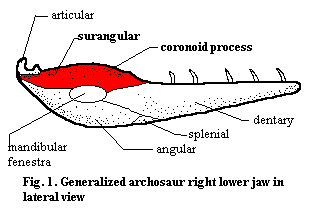
ptosaurs,crocodilians, and dinosaurs, including birds
mammals and lepidosaurs
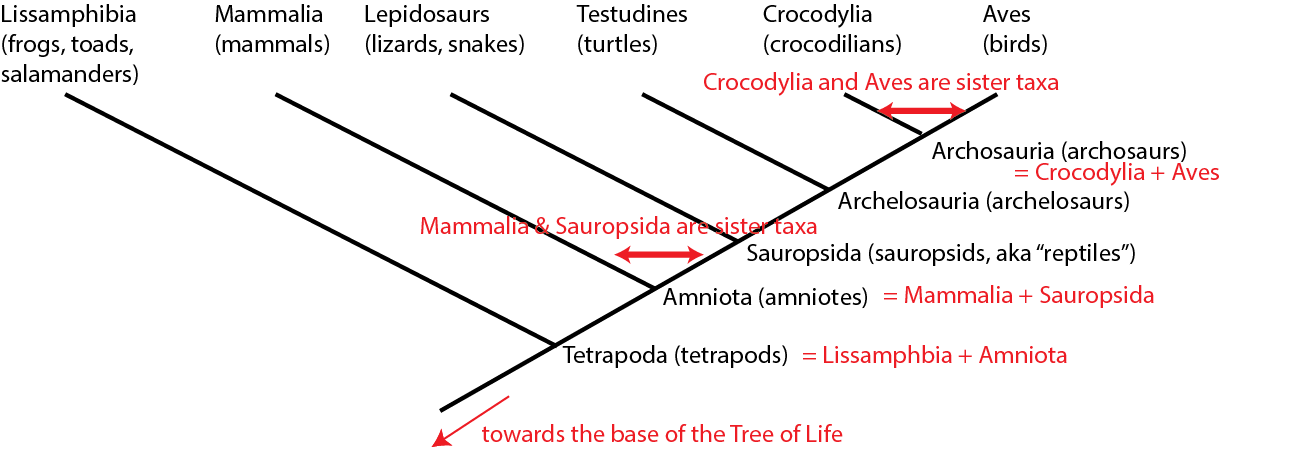

1 alligator skull, 1 lizard skull, 1 turtle skull
Based on the characters you see in these sketches, which two would you expect to be most closely related? Is this expectation currently viewed as the most likely correct pattern of relationships?
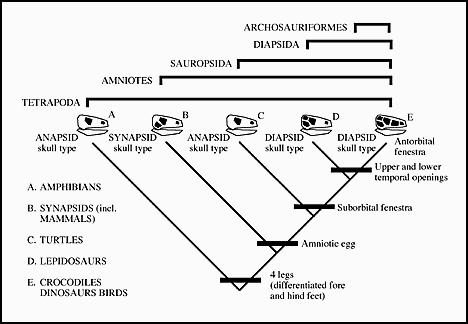
mostly : alligator and lizard= diapsids true, bc turtle secondarily lost
not accurate bc turtles thought to be closer to crocidiles than birds or lizards
turtle skull

Does the surface texture of a bird egg shell more closely resemble that of the turtle or alligator, and why? From an evolutionary standpoint, why might that make sense?
Bird: smooth/porous
All: smoooth/dent
Turt: smooth
bird & alligator bc surface texture form of pitting and porous makes evolutionary sense bc birds and crocs more close related to eachother than either to turtle
Describe the differences between the shoulder girdle in the turtle and the cat in the following features:
- (i) Shape of shoulder girdle
- (ii) Position of shoulder relative to the ribs
cat: 1 large flat bone & spine outside rib cage
Tur: triparte 3 bones & INside ribcage/ shoulder girdle
Know bc turtle ONLY animal w/ limb girdles INside ribcage
PLEURODIRES VS CRYPTODIRES
(SIDENECK TURTLES) -fold sideways
(HIDDEN-NECK TURTLES)- fold midline of body
What distinctive feature visible as part of the body of chelydrids is absent in other turtles?
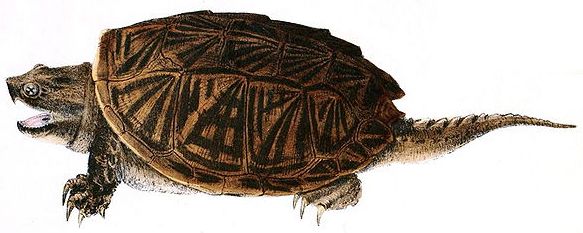
long tail
Slider (adult)
- Low domed shell, streamlined (blunt front,
tapered back)
- Strong webbing on hind feet (big paddle for
swimming), but forefeet pretty small
• Map turtle (juveniles)
- Prominent keels (raised ridge
running from the front to the back) on the carapace
-Keel on shell purpose and diff color
stabalize swim
signal species recognition, camoflauge, hide from predator
sea turtle and swimming
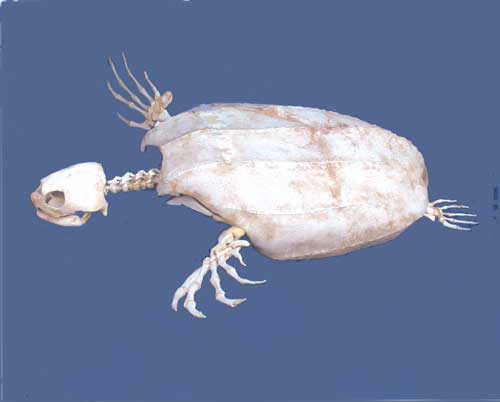
synchronous lift based, continuous, active fore not hind
softshell turtle swimming

asynchronous, drag based, not continuous, fore and hind active
v fast, not move bury in sand, long nose help burry stick nose out long neck length to stick out nose

One of these two lineages actually belongs to the emydid clade and is closely related to animals like the slider (Station 6). Based on the structure of the hind feet, which of these lineages (tortoises or box turtles) do you think that is?

box more close to slider bc has a discernable ankle strong webbing
Crocodilians:
gavials, alligator and crocidiles
why crocodilians are related to birds by comparing a croc skull to the ostrich skull available at this station and identifying the hole in the lower jaw that they share (the mandibular fenestra)
gavial- long, narrow nose
crocodiles, 4th tooth in the lower jaw projects out of the mouth and is visible when the mouth is closed; this is not true in alligators.
-alligators have broader snouts than crocodiles.
crocidiles have
bony secondary palate
Alligators have the strongest measured bite force of any vertebrate, yet you may have heard that it is possible to hold their jaws shut with one hand. Examine the lower jaw of the alligator and explain why that might be true
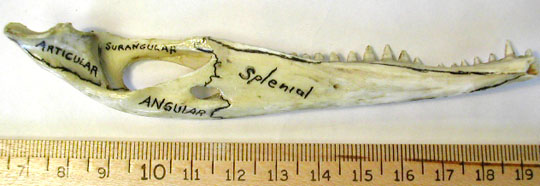
v weak jaw opening
bc out lever for opening and closing is the same
in lever v big in close and v small in open
tuatara skeleton
What is distinctive about the distribution of teeth?

tuatara’s closest relatives are an extinct group of reptiles around at the time of the dinosaurs-- rhynchocephialia
diapsid
2 rows of teeth on upper and lower fit in btw shearing
basic lizard body plan
iguana- dewlap, varanids active predators gular pump, skinks regrow tail/ sex dimorphism, geckos- glide/ptychozoon toes sticky , chemelon-zygodact, Phrynosoma asio (Horned lizard); 1 jar Moloch horridus (Thorny devil)
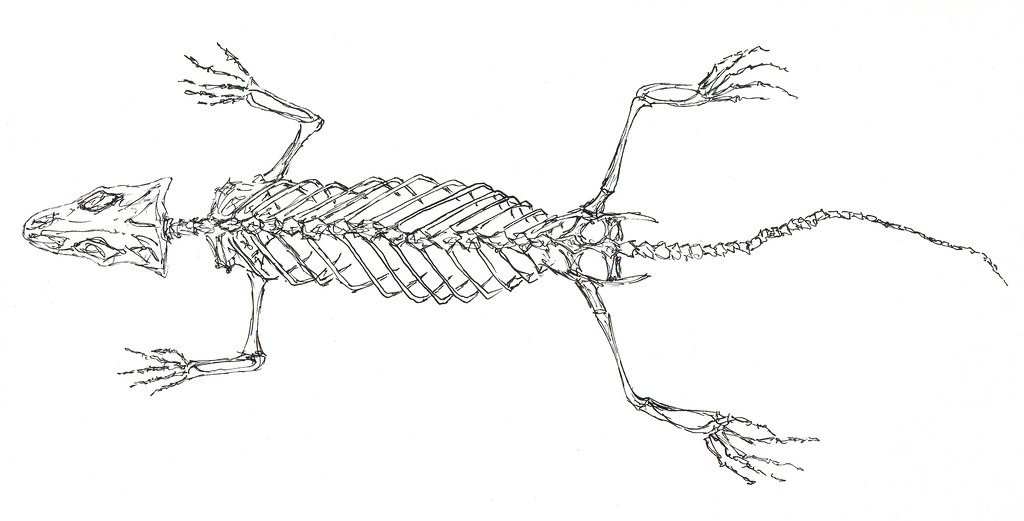
diapsid, long tail, normal skull, usually legs w/ hind>fore, vent, sprawling limb posture, laterally compressed, bend the body side to side when they walk, squeezing air out of 1 lung while they exercise
Zygodactylous Feet
having 2 or more toes reversed
Having two toes projecting forward and two projecting backward,
chameleon )2 and 3 on fore and 3 out and 2 in on hind
-- woodpeckers
tail regrow-- skinks
Skinks, like many lizards, are able to regrow the tail if it is broken off (but only once per lifetime). if the tail is grabbed by a predator. some species even have a zone of weakness where the tail can be automatically self- amputated by the lizard and left behind to distract predators. Regrown tails are not exactly like the originaldon’t have separate vertebrae for a skeleton, but instead grow a single fibrous rod- color or length
sexual dimorphism- skink
differences in appearance between the males and females of a species
male= bigger and larger head, bright orange but in jar brown
fm= smaller stripped
basilisk
Jesus Christ lizard run over water
gila monster- venom, frill- fan, glass (revolutions0 no limb, anoles- horns/change color, raceruner- parthenogenic, fence lizard==== all lizards
snake vs lizard
both limbless
- Lizards have external ears and snakes do not
- Lizards have relatively long tails, snakes have relatively short tails
- Lizards have multiple ventral scales per row, snakes have only one
snake specializations
limblessness
pathogenesis
A form of reproduction in which an unfertilized egg develops into a new individual, occurring commonly amonginsects and certain other arthropods.
all female
- AMPHISBAENIANS
- BIZARRE, DERIVED LIMBLESS BURROWING LIZARDS
- predators, burrowers, shovel head, lost limbs, short tails
Snakes
limbless, v special skull- v mobile bony strut, eat bigger than head, special teeth for venom, most nonvenom

rattesnake
wider/ robust
fangs w/ venom

colubrid
thinner
no fangs
solenoglyphous
aposematic
retract fangs- viper
bright colors are poison
true viper
pit viper
elapids
king cobra
pythons
no pit - sense prey
w/ pit - python - 1 pit
poison
largest, smooth
pit heat detect, boidae-- series of pit organs
All other reptiles than snakes are
few lizards & several snakes
Oviparous- lay eggs
viviparous
birds
closest living relative to crocadiles
Archaeosaurs- special dinosaur
earliest= Archaeopteryx
united by lower jaw fenestra
Living birds have 2 clades
1- Ratites
2- Neoaves (modern)
bird synapamorphies
breastbone =sternum
furculum= wishbone
NO TEETH
• Reversed hallux (i.e., 1st toe)
• Wishbone (furculum): fused
collar bones between the arms
• Sternum (breastbone): on chest
midline, large keel projects ventrally from it (for origin of flight
muscles inserting on wings)
• Rearward pointing uncinate processes on ribs
• Pelvis
heavily fused into a synsacrum (useful for bracing against impact of
landing)
• Short tail, with last vertebrae fused into a single
bone (the pygostyle)
• Distal to wrist, hand bones are fused
into a carpometacarpus (the long, bow-shaped bone) and only 3 fingers
• Birds walk on their toes (digitigrade foot posture). They have no distinct tarsals (ankle bones); instead, tarsals are fused onto the distal end of the tibia (to form a tibiotarsus) and the proximal end of the metatarsals (which are themselves fused together, forming a tarsometatarsus)
• Femur held horizontally, most leg movement at knee during walking • Fibula reduced to splint in lower leg
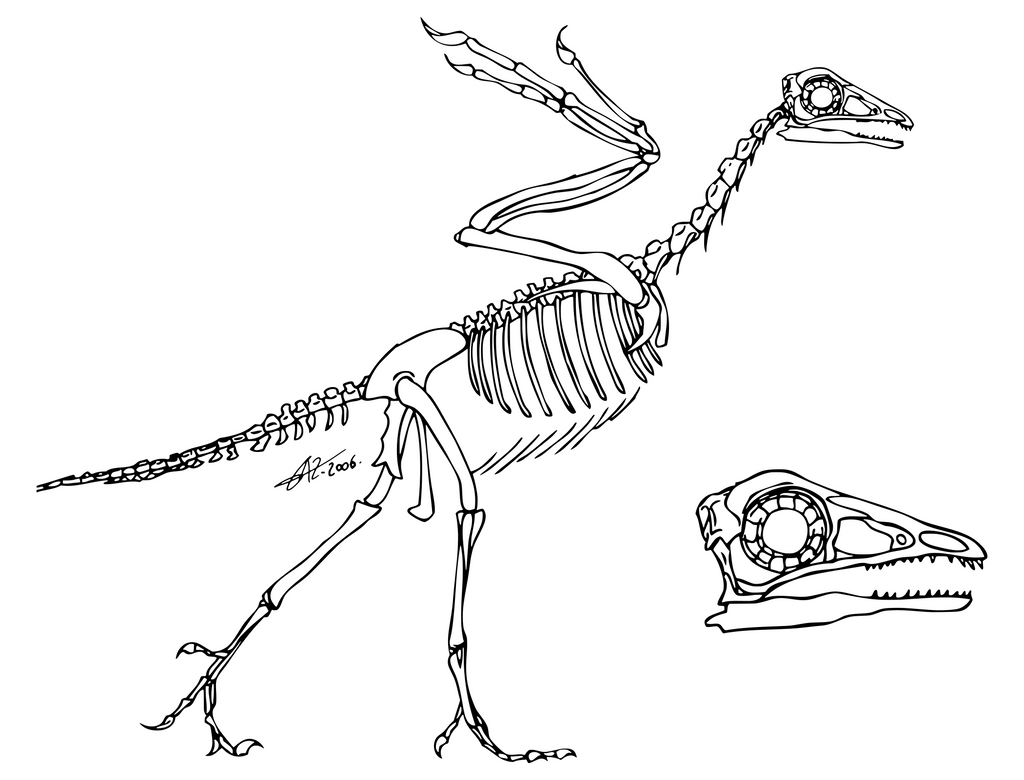
archaeopteryx vs modern birds
hands
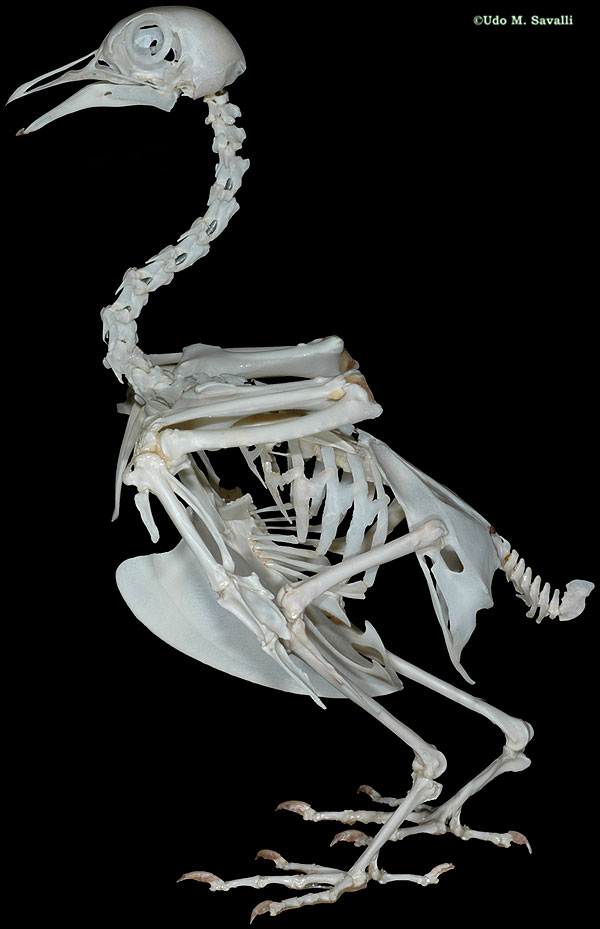
A: unfused finger bones, 3 clear distinct digits
Mod: fused finger bones

archaeopteryx vs modern birds
tail
a: long tail
m: short
archaeopteryx vs modern birds
Pelvis
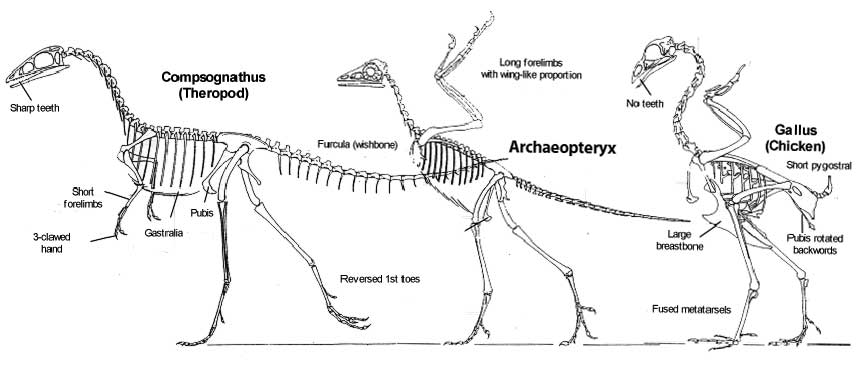
A: pubis points straight up/ forward
M: pubis points backward/ down large, broad fused synsacrum

contraction of different sets of muscles power downstroke and upstroke during flight. attachment of the furculum between the wings. During the downstroke of flight, the furculum arms are actively pulled apart by wing motion. During upstroke, the furculum arms will tend to spring back to their original shape. Why might this be advantageous to a flying bird?

conserve energy w/ spring, exert to pull apart on down stroke, but no use on upstroke
Ratites
ostriches, emus, rheas, cassowaries, and tinamous, and are distinguished by several features related to the loss of flying ability and a shift to running habits. The ostrich egg is the biggest of any living bird (not surprising, as ostriches are also the biggest living birds!)
ratites vs. neoavian
sternum

E: no big keel on sternum, relatively straights
N: curved. slanted
ratites vs. neoavian
Relative prominence of forelimbs vs. hindlimbs
Hind larger: Emu> neo
Fore larger: emu< Neo
think emu long legs
precocial
altricial
p= babies are able to wander around and feed themselves very shortly after hatching, precocious, even if they do tend to hang around and follow mom for a few months
a= hatchlings are needy and demanding, unable to care for themselves and stay in the nest to receive food from parents,feathers and wings are poorly developed

baby ostrich at the previous station – do you think it is precocial or altricial? What is your evidence, and why might this life history strategy be advantageous given the ostrich’s habitat and locomotor habits?
Precoicial bc feather/limbs well dvlped, not proteced by nests in trees so need to be able to flee predators
Primary feathers are the feathers that emerge from the hand of a bird; secondary feathers are feathers that grow out of the forearm (ulna). Describe how the relative surface areas of primary and secondary feathers relate to the flight style of birds – for example, how do primary and secondary feather areas compare between the black vulture and the peregrine falcon?
1= good speed & manueverability
2nd= generating a lift
vultures lift based so more 2nd, falcon fast so more 1st
Besides the features of the skull we’ve already discussed, another feature that lets us know that birds are related to other reptiles is that birds possess scales on parts of their skin. In some places these look like standard scales (see the bird foot station later). But, the most common body covering of birds,...
.. feathers, are also really just highly modified scales. (How do we know this? Feathers and scales show similar patterns of development, an important standard for evaluating homology that we learned about in our first lab).

Molt
new feathers grow from
barbs rachis calamus
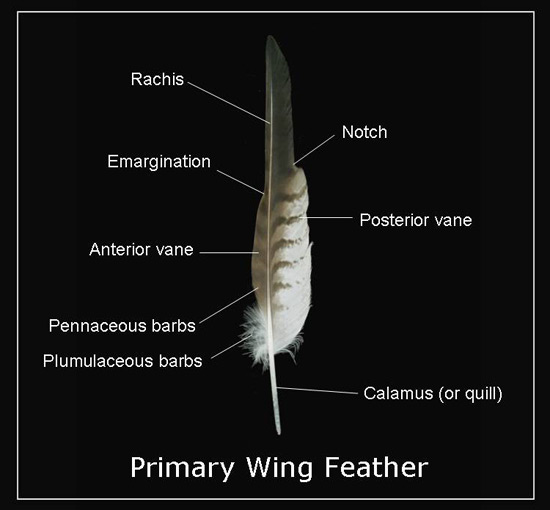
New feathers grow out of a sheath at the base of old feathers, and their growth pushes old feathers out to replace them, commonly during a fairly brief period called the molt. All feathers have a central shaft and smaller shafts, called barbs, which emerge from the distal part of the shaft. The portion of the shaft from which barbs emerge is called the rachis; the portion without barbs (where the feather attaches to the body) is called the calamus.
...

What is different about the surface area of the barbs (called the vane on flight feathers) between the leading and trailing edge?
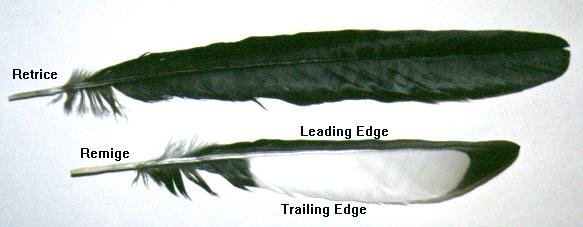
Primary: SA greating on trailing
2nd: both sides equal so not have lead/trail
Bird Calls
Mallard:
Mourining Dove
Sandhill Crane
m: quack- donald duck, cackling
Dov: owl, quiet, cooing, pleasant
crane: rubber, rubbing a ballon, vibration resonates= wide trachea embedded in sternum
reversed hallux
big toe/ innermost digit of hind foot rvsed backwards
which means that the big toe (digit 1) points posteriorly. The feet here show several modifications of this basic pattern
Birds have no more than 4 toes on their hind feet. So, what do you suppose that makes the spur on the foot of the turkey? In male turkeys the spur is well developed, but in females it is a tiny nub, if noticeable at all. What do you think that means about how turkeys might use the spur?
spur modified scale males combat
Notice the webbing on the duck feet. Ducks swim by rowing their feet like paddles. Which foot position of the 2 displayed (open or closed) do you think ducks use on the rearstroke of swimming, and which do they use on the forestroke?
fore: closed
hind: open
beak-bones of skull covered w/ layer of keratin
modern no teeth but fossil had them
heron stabbing:
snipe probe soft sand invert:
skimmer surface of water catch fish

- big pointed spear
-long beak probes
-blade shaped, lower jaw cut through water
Ducks (including geese and swans) and fowl (chickens, pheasants, turkeys, and quail) are close relatives.
ANSERIFORMS AND GALLIFORMS (DUCKS & FOWL)
Both walk well on the ground. Galliforms (fowl) tend to fly only for short distances and are typically non-migratory. In contrast, Anseriforms (like ducks) are excellent flyers and many undergo extensive migrations (e.g. Canada geese). Anseriforms are also strong swimmers that use their feet like paddles to row at or under the surface. Males of both groups are often brightly colored, and in galliforms in particular they may present elaborated feathers and perform elaborate courtship displays (e.g., peacocks). Unlike peacocks, males of the pheasant species displayed here do not flare posterior feathers for display, but instead flare out feathers in the throat region.
close relatives kinfisher and hornbills
woodpecker and toucan
toes fused at base not end= pads
zygodactylus feet- and parrots

PENGUINS, LOONS, WADING BIRDS, PELICANS, OCEAN-GLIDING BIRDS close relatives
Pelicans foot, loons, and penguins all swim. Describe the differences in foot structure among these 3 groups based on our specimens, particularly noting the extent of webbing between the toes. What do these differences suggest about how penguins might swim compared to the other groups?

Pelican: all 4 have webbing
peng: no webbing- aquatic flight not feet-- shown
Loon: webbing on all 3 ( not halluxed)

mammals are the only living members of a larger clade, ____which also includes several fossil ancestors and relatives of mammals (the “mammal-like reptiles”

Synapsida,
synapsids are distinguished from other amniotes by the pattern of holes (temporal fenestrae) in the back of their heads (Fig. 1): synapsids have a single temporal fenestra, whereas reptiles have either no temporal fenestrae (anapsids, the primitive condition) or 2 temporal fenestrae (diapsids, a derived group that includes lizards, turtles, crocodilians, and birds)
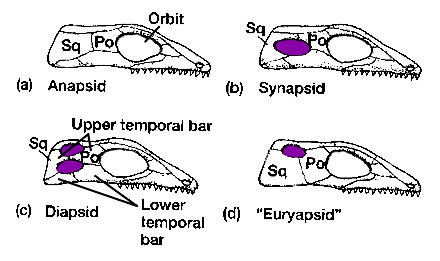
Mammals can be distinguished from other synapsids by several features:
SEVERAL KINDS OF TEETH
hair, mammary glands, and 2 new ear bones that are derived from the bones that formed the articulation of the skull and lower jaw in other vertebrates (and, as a result, there is only 1 bone in the lower jaw of mammals).
HETERODONT
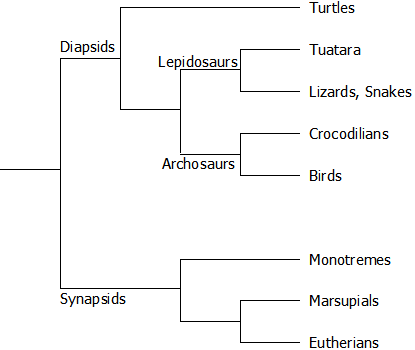
Living mammals are typically divided into three major groups: monotremes, marsupials (also called metatherians), and eutherians (sometimes called “placental mammals”).

Marsupials and eutherians are sister taxa, based on their shared possession of a distinctive type of tooth, the tribosphenic molar

orbit vs. temporal fenestrae
Dimetrodon is a synapsid, and therefore one of our distant relatives.
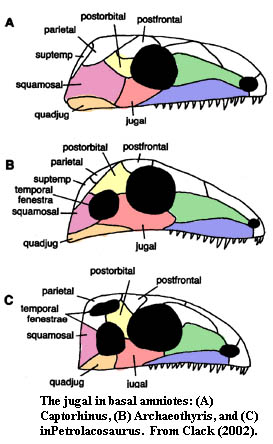
know where orbital stops- post orbital process
temp: massive all the way back allow muscle attachment, all ontop of head

types of teeth mammalian

heterodont
carnissal: 4th upper premolar & 1st lower elaborate- sheath
incisor: fronth lower jaw
molar- 4 back teeth upper
Compare the back of the skull in Dimetrodon to that in the cat. How has the size of the temporal fenestra (relative to the size of the skull) evolved over the last 280 million years between mammals and their ancestors?
cat larger -- gets bigger in modern animals
BASAL MAMMALS: MONOTREMES
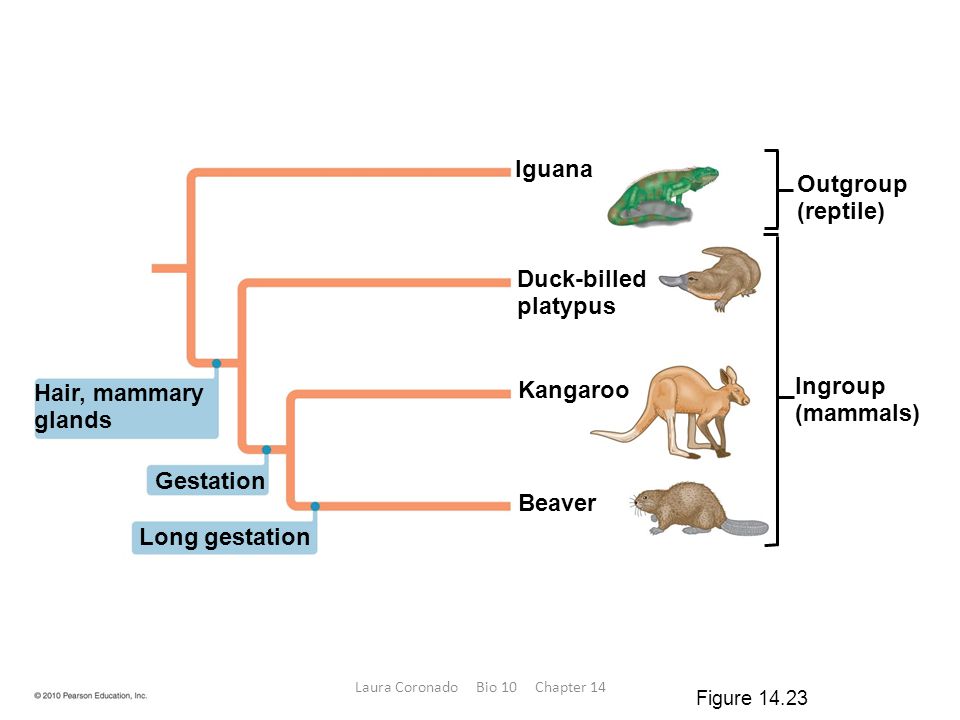
1 platypus & 2/3 echidna species of anteaters
- Lay eggs!
- Testes undescended (i.e., in abdomen)
-
Have a cloaca! (single exit for digestive, excretory, reproductive
tracts) Hence the name “Monotreme” which means “1 opening”
Platypus
- - Platypus highly aquatic with strongly webbed feet; they have a fleshy bill on snout capable of detecting electrical currents produced by prey!
- - Male platypuses have spurs on hind legs that exude venom – one of very few venomous mammals!
- - Adult platypuses have no true teeth in jaw, only horny plates.
Echidna
- - Echidnas have no teeth and are specialized for eating ants and other insects (convergent on more familiar anteaters – more later)
- - Echidnas direct the toes of their hind feet outward and backward!
- - Echidnas can roll into a ball that exposes sharp, pointy spines derived from hair
- No doubt about it, modern monotremes are very strange mammals. As strange as they are, we know they are mammals because they have fur, and because females produce milk for their young. But, we can’t see these features in skeletons. What features of these specimens let you know for certain that they are true mammals?
1 temporal fenestra & Lower Jaw only made of the DENTARY-1bone
Marsupials
2 features reproductive
complete placenta- covergent evolution
- reproductive tract of female marsupials is bifid: in other words, they have 2 uteri. Embryos have an incomplete placental attachment to the wall of the uterus, and young are born at a very early stage of development, often before the eyes and hind legs have formed.
- In many (but not all) species, females have pouches that surround the teats: young can then be carried and suckle in the pouch.= atricial
- Teeth are very important features for establishing the relationships and distinctiveness of many mammal groups. Examine the molars (4 back teeth) of the upper jaw in the Virginia opossum. Notice their triangular shape, with the apex pointing in toward the throat and the base along the outside where the lips would be. This tooth shape is called the

- tribosphenic molar, and it is a distinctive feature that unites marsupials with placental (eutherian) mammals in the clade Theria complicated interlocking of tooth cusps in mammals (called occlusion) – considerably different than what we saw in reptiles! As a primitive feature, marsupials tend to have more teeth in the jaw than other mammal lineages
Epipubic bones
- Mouse opossum pelvis
- Kangaroo foot: notice the extreme reduction of two of the toes, producing a functionally 2-toed foot

- extra bones projecting forward from the pelvis in the opossum. -also be found in monotremes, some fossil mammal-like reptiles, and some early fossil eutherian mammals.
- They provide attachment for abdominal muscles that help to coordinate breathing with locomotion, and are believed to have been lost among derived eutherians as young began to be carried to larger and larger sizes in the uterus before birth.
- Incisors (front teeth) in lower jaw of kangaroo vs Virginia opossum: The condition of the lower incisors divides marsupials into 2 major groups:

Diprotodonts (e.g., kangaroos) have 2 elongated lower incisors (Notice: “diprotodont” translates as “two front teeth”).
Polyprotodonts (e.g.,opossums) have multiple small lower incisors (Notice: “polyprotodont” translates as “many front teeth”).
bipedal animal
increase power= increase SA= increase muscle size= increase temporal fenestrae size
Forelimbs v small<<< Hind limbs (salatorial jump kangaroo)
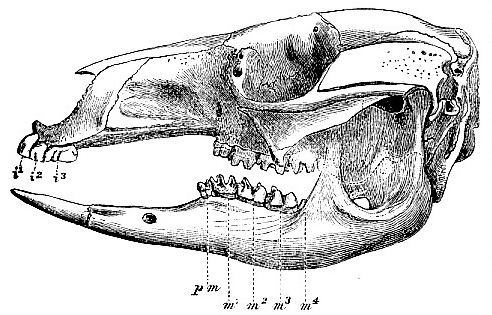
The kangaroo and the Virginia opossum show different strategies for expanding the area of attachment of jaw closing muscles (temporalis). Compare the skulls and lower jaws of these species and describe these different strategies (hint: remember where jaw muscles both originate and insert).

both= large bite force accomplish diff way
K: big pockets in mandible for attachment of jaw muscles- pterygoid, increase SA on both sides & much bigger masseteric fossa allows attach of the masseter muscle, smaller temporal fenestra
Op: no pocket, large ridge on top of skull greater SA in temp fenestra bigger bone more SA for muscle attachment
BASAL EUTHERIAN MAMMALS: XENARTHRANS (=EDENTATES)
NO teeth & strange joing ZYGAPOPHYSES
possession of a complete placenta that attaches the developing embryo to the uterine wall in the mother, allowing for nutrient supply; this placenta develops from 2 of the original membranes that contributed to the amniotic egg: the chorion and the allantois.
xenarthrans (formerly categorized as edentates), have classically been considered the most basal clade of eutherian mammals. They include 3 seemingly disparate, but fairly familiar groups of mammals:
the sloths, the anteaters, and the armadillos. (Note that aardvarks are a distinct clade, the Tubulidentates, that are not part of this group). Armadillos are especially distinctive because they possess armo
2 names for this group signify 2 of their most distinctive features: “edentate”
Xenarthra

-means “without teeth”. only anteaters lack teeth entirely. However, no living sloth, anteater, or armadillo has incisors or canine teeth, and in many (like armadillos) the teeth have a simplified structure.
- means “strange joint,” which refers to one of the distinguishing features of this group: extra articulations (called zygapophyses) between vertebrae that are not found in other mammal groups. These are present between the vertebrae of the backbone (as you’ll see shortly) and provide extra rigidity to the axial skeleton.
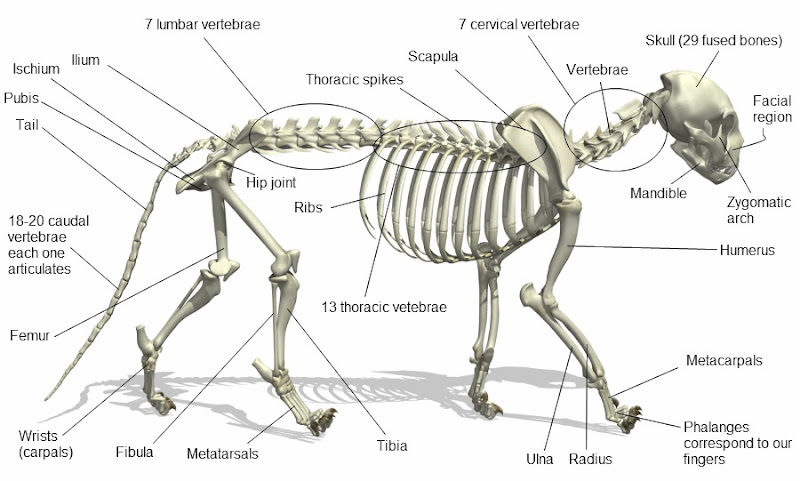
similar among xenarthrans but differ from the cat
(a) Facets of articulation on posterior side of vertebrae (not visible for mounted armadillo). Check the giraffe for an easier to visualize representative eutherian.

X: 2 facets on each side for the insertion of zgypophyses (total of 4) fits like a puzzle
typical eurian animal- 1 facet on each side (total=2) lay on top
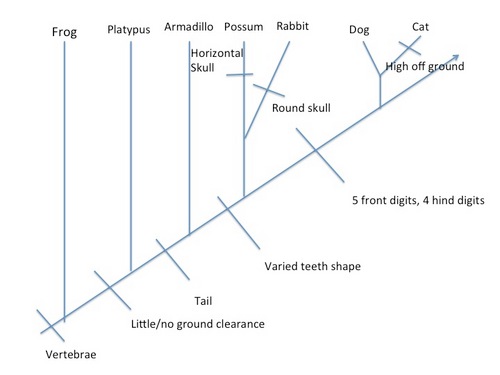
similar among xenarthrans but differ from the cat
pelvis
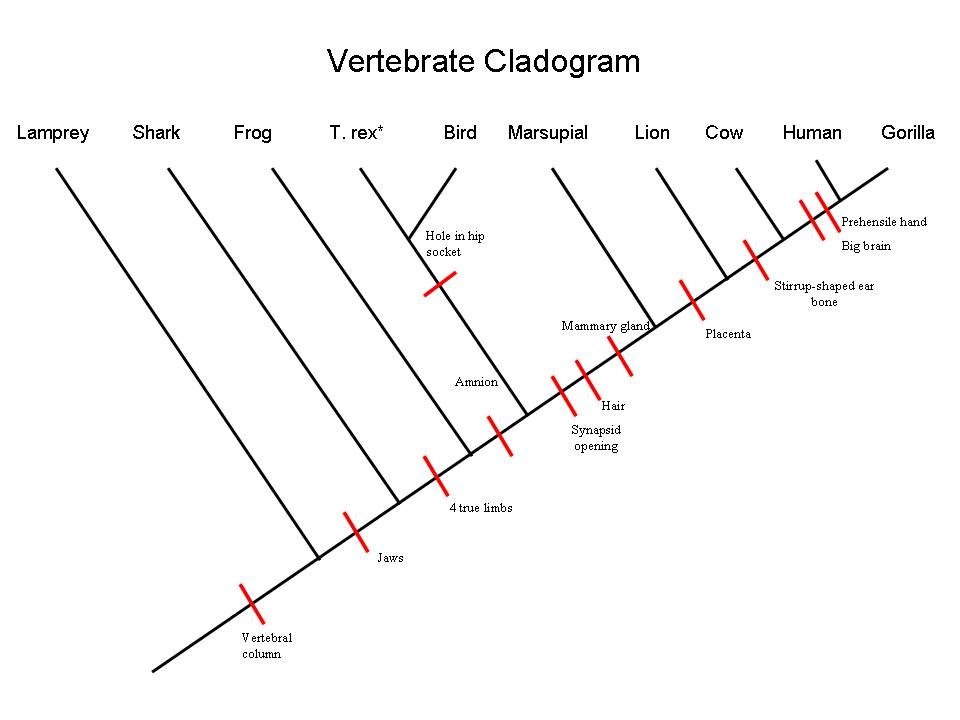
X: completely fused w/ vertabrae
cat: separate
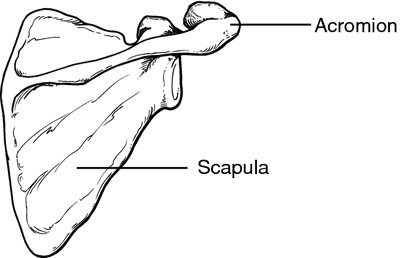
similar among xenarthrans but differ from the cat
scapula
X: v large acromian processes
c: smaller y less SA

similar among xenarthrans but differ from the cat
distal humerus
x: hummerus flattened and spread out for additional SA for muscle attach, commonly seen in digging animals via CONVERGENT evolution
cat: v short in lever

- Pangolin: Incomplete zygomatic arch (less area for jaw muscle attachment), simple mandible and no teeth
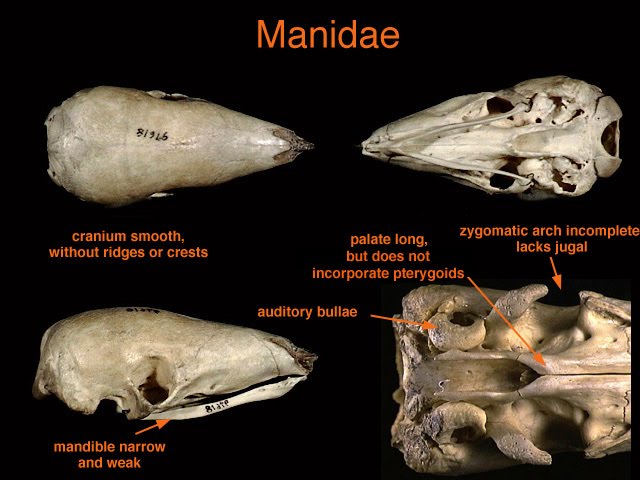
- Aardvark: Reduced dentition (you may be able to see small holes from tubules within the teeth; hence the name Tubulidentates or “tubule-toothed”)

INSECTIVORANS- 5 clawed digits each limb mole
- Examine the forefoot of the mole skeleton. How has the mole broadened its hand laterally, and how do we know that the bone isn’t a digit?

mole= 1 carpal that is expanded out looks like 6th digit no claw so not digit also know not digit bc where it comes out of paw

- RODENTS AND LAGOMORPHS (RATS & BUNNIES)- sister taxa
- both= incisors are also followed by a gap in the tooth row, called the diastema.

- - Distinctive lateral openings of the skull in front of the eye in the rabbit
- - Check out the most posterior upper tooth in the capybara – much longer than other teeth

Closely compare the upper jaw incisors of the rabbit and normal woodchuck. What is distinctive about these teeth in the rabbit?
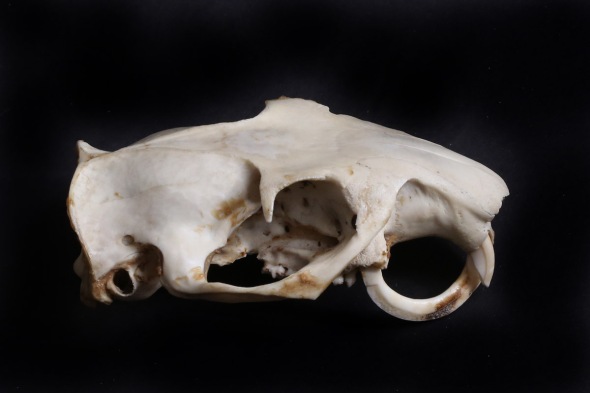
wood pic
r- 2 small inscisors behind 2 large
w- large long rounded continual growth around, maloccluded (“badly fitting”, referring to teeth)not worn down enough
CONVERGENT EVOLUTION IN GLIDING MAMMALS
sugar gliders and flying squirrels have a flap of skin (the patagium) that extends between their fore and hind legs that they can spread out to form an airfoil that generates lift, slowing the rate at which these animals fall when they jump out of trees and allowing them to steer and control their heading
convergent structures because marsupials and rodents are not sister taxa, so the patagium must have evolved independently
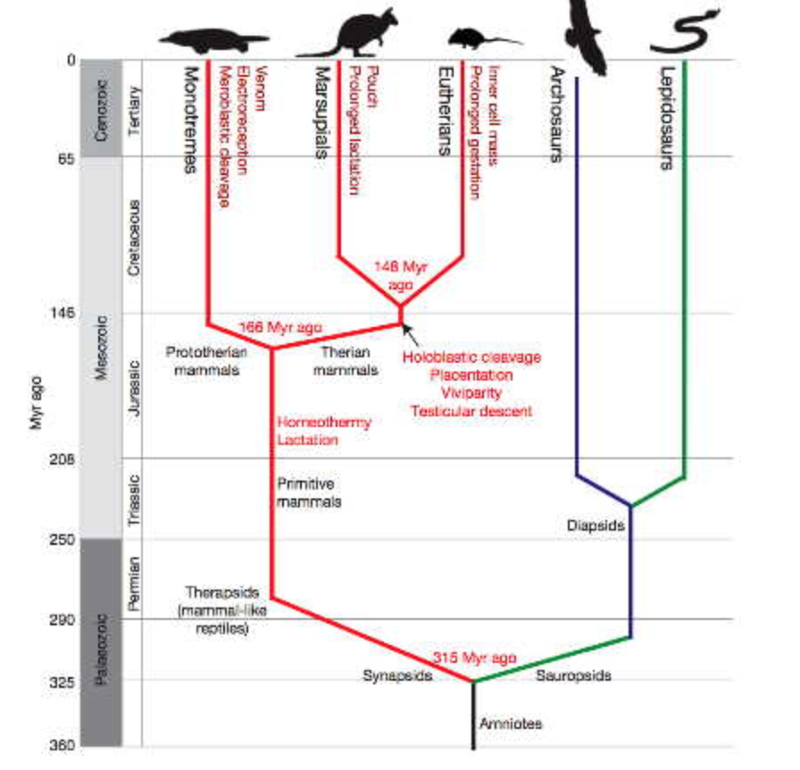
KNOW PICTURES
Marsupials and rodents no sister taxa
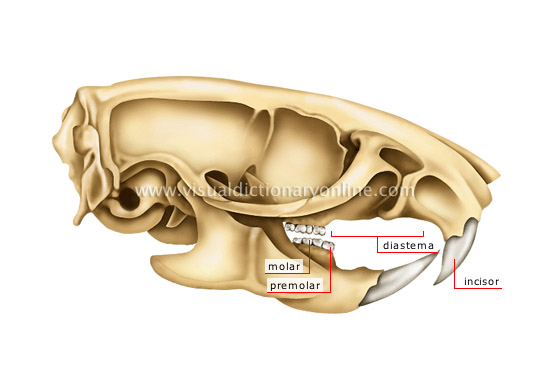
how could we tell that these animals belong to marsupials and rodents pict, respectively? Well, as we mentioned earlier, the teeth are important features for telling what kind of mammal you have on your hands.
- (a) Compare the jaws of each specimen and note three features that let you distinguish the rodent teeth from the marsupial teeth (Hint: how many incisors do they have? Where do they have enamel on their teeth?).

1-Rodents have enamel only on anterior portion of teeth
2- rodent have iron deposits on teeth, marsupials do not
3- marsupials picture have more than 1 pair of upper inscisors, rodents only have 1 pair
---

- ---Based on the teeth, to which marsupial lineage that we noted in Station 3 do sugar gliders belong (in other words, are they more closely related to kangaroos or opossums)?

more Kangaroo bc pockes= DIprotodonts
marsupials

kangaroo opossum

Compare the wing skeletons of the birds and bat. How do the structures that support the wing differ? (Note the hand and forearm in particular)
CHIROPTERA (BATS)--the only mammals in which powered flight has evolved. They are divided into 2 major groups: Megachiropterans (fruit bats and flying foxes) and Microchiropterans (all other bats).
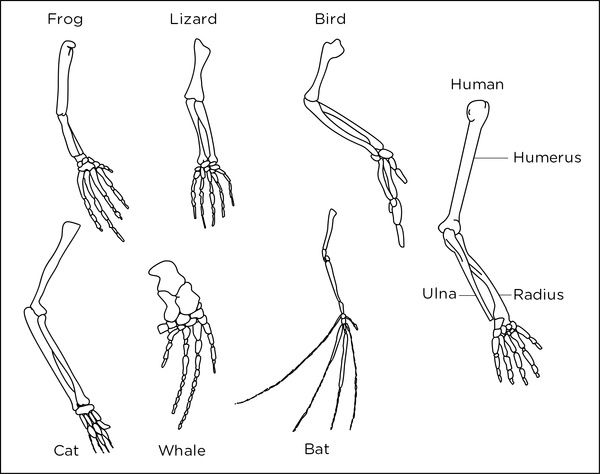
Bat: digits support the wing, elongated fingers, 1 forearm bone reduced not support but made into a hook at end
bird: digits are not independent

PRIMATES
including humans, are believed to have bats among their closest living relatives (our likely closest relatives are the tree shrews
synap:
and MANY clades

(1) the presence of nails, rather than claws, at the tips of digits; (2) forward directed eyes, aiding depth perception; and (3) generalized teeth, generally indicating omnivorous diets.

Primate clades
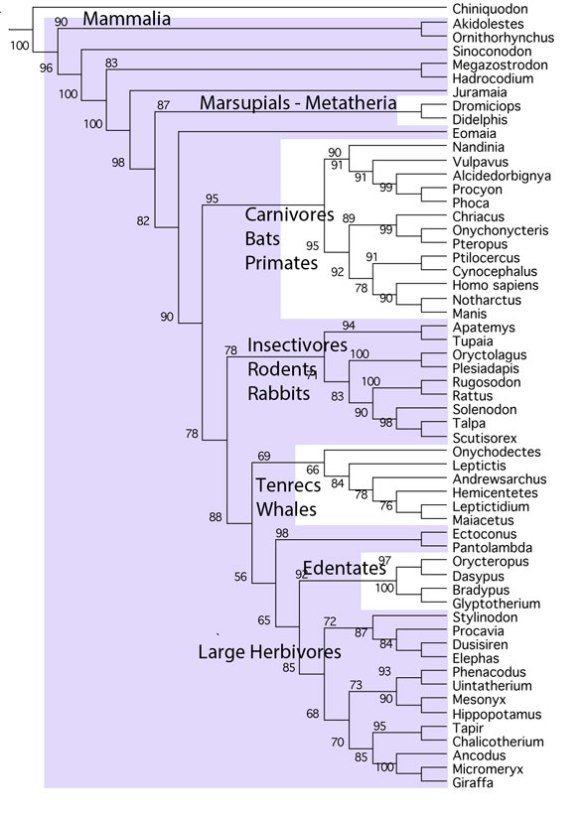
most basal clade is the Strepsirhini, in which the upper lip is divided. Today this clade includes only the living lemurs and lorises. All other primates are grouped together as Haplorhini, in which the upper lip is undivided. Some major haplorhine clades include the Cebidae (New World monkeys), the Cercopithecidae (Old World monkeys), and Hominidae (great apes: humans, chimps, gorillas, orangutans). These latter 3 groups can be distinguished by features of the tail: cebids typically have prehensile tails that can be used to grip objects; cercopithecids have long, but non-prehensile tails; and hominds have extremely reduced tails.

Multiple syncytin gene captures and diversity of placental structures in eutherian mammals. (a) Phylogenetic tree of mammals, with the four major clades of eutherians: (I) Afrotheria, (II) Xenarthra, (III) Euarchontoglires and (IV) Laurasiatheria (adapted from Meredith et al. [61]). The four basic types of placentation are indicated by coloured squares (the colour code corresponds to that of the boxes that frame the images shown to the right). The time of insertion of the different syncytin genes identified to date is indicated. Branch length is proportional to time (in million years, Myr). (b) Schematic colour-coded representation of the maternal–fetal interface in the four main types of placental structures. Placental types are classified from top to bottom in the order of decreasing extent of syncytialization and invasive properties.
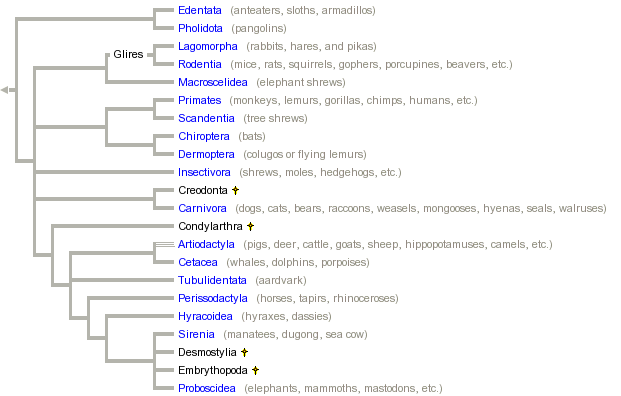
know!!
Examine the orangutan skull and identify the foramen magnum, where the spinal cord exits the skull from the brain. How is the foramen magnum oriented and what does this indicate about how the orangutan holds its head and back?

on bottom of skull indicate head is facing forward and back is curved

CARNIVORANS--
bears (Ursidae), dogs (Canidae), cats (Felidae), weasels, skunks, & otters (Mustelidae), raccoons (Procyonidae) and several marine mammals (seals, sea lions, and walruses: Pinnipeds).

mainly carnivorous (meat-eating), and can be distinguished by possession of carnassial teeth, an elaboration of the 4th upper premolar and 1st lower molar into shearing teeth for cutting meat. Some carnivorans have adopted a more omnivorous diet, and in these animals the carnassials may take on a more standard, molariform shape
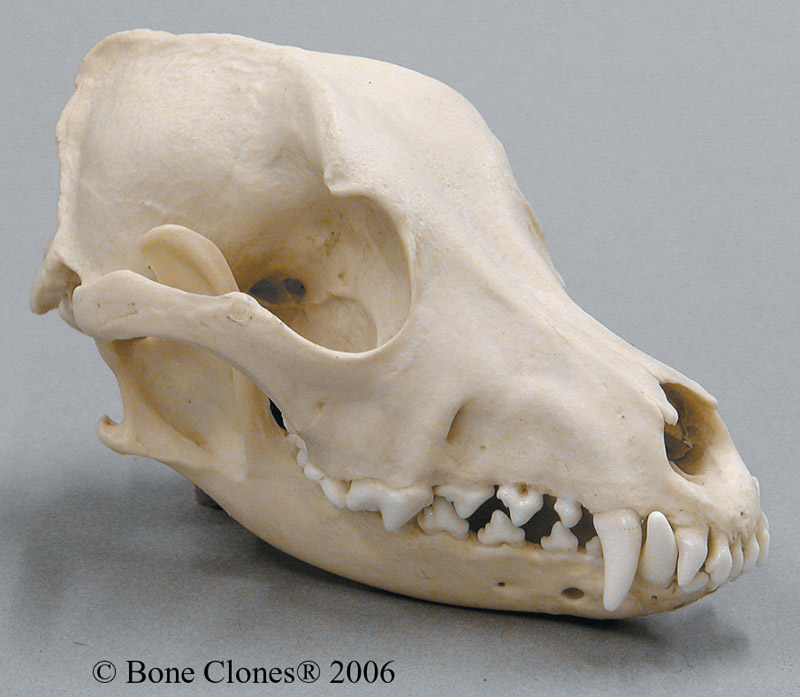
Domestic dogs are closely related to coyotes – how can you tell their skulls apart?
(A) POSTORBITAL PROCESS (process that is dorsal and posterior on the orbit)
(B) SLOPE OF FOREHEAD

a: Coyotes larger and pointer more prominant, more SA picture
dogs less SA
b: Dog= bigger/deeper slope
coyotes= less/shallow
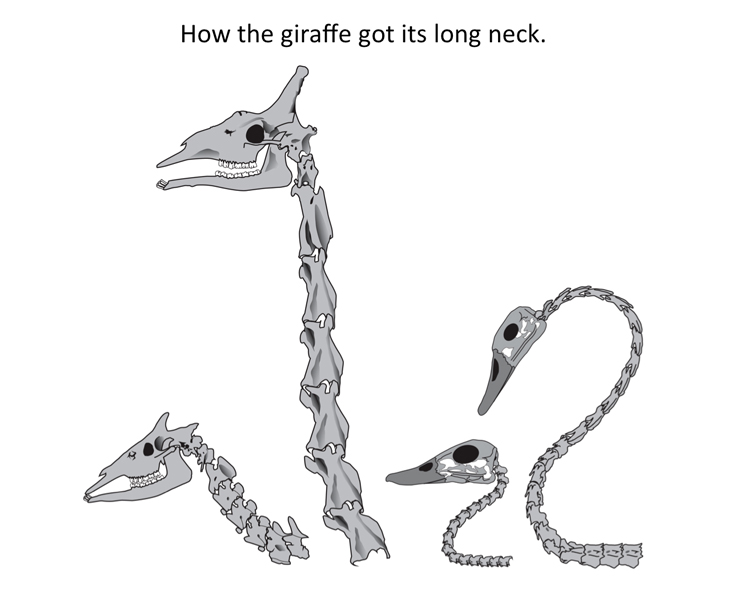
Giraffes are characterized by having very long necks. Birds can elongate their necks by either increasing the number of neck (cervical) vertebrae, increasing the length of each individual vertebra, or by using both of these methods. Compare the giraffe’s cervical vertebrae to that of the cat, which has 7 cervical vertebrae. Which method does the giraffe use?

increasing the length of each individual vertebra,bc has 7
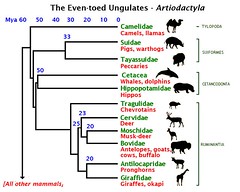
ARTIODACTYLS AND CETACEANS
camels (Camelidae), pigs (Suidae), deer (Cervidae), pronghorn (Antilocapridae), giraffes (Giraffidae), hippos (Hippopotamidae), and the goats, sheep, cattle, and antelope (Bovidae). These groups were once considered one of the two main branches of the group Ungulata, sister to the Perissodactyls (see below); however, recent evidence indicates that perissodactyls are actually more closely related to the elephants, hyraxes, and sirenians (manatees).

Artiodactyls are a group of 200+ mammals distinguished by a foot structure in which there is an even number of digits (2 or 4 in both fore and hind feet
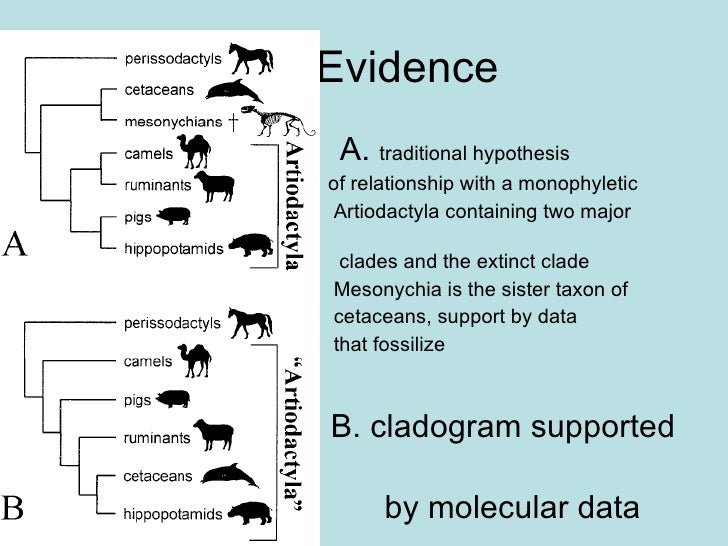
know
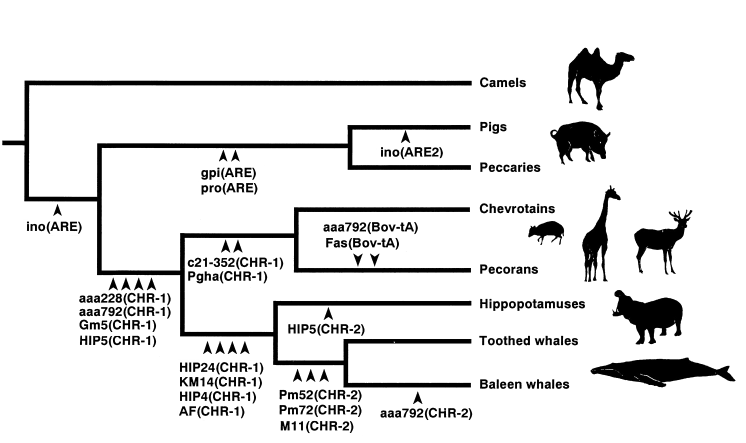
right

- Cetaceans can be divided into two suborders: Mysticeti (baleen whales) and the Odontoceti (toothed whales)

o Baleen (derived from modified mucous membrane): in whales with baleen, water taken in the mouth is forced back through the baleen by the tongue, sieving plankton and other tasty food bits out. Not all whales have baleen – see next bullet point!).
o Teeth in odontocetes (e.g. the river dolphin) are typically homodont, simple, peg-like and are not replaced (i.e. they only have one set of teeth!).
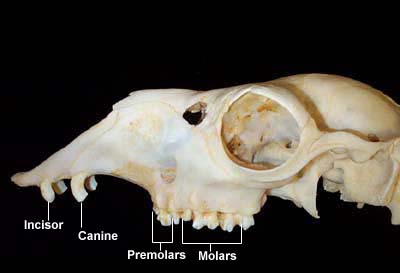
camels picture, antelope, and horses (domestic, but possibly escaped). Compare the upper jaw teeth (anterior to the cheek teeth) in the camelid, the antelope (gazelle,, and the horse (actually a mule, but close enough) What features distinguish each, letting you fulfill your dying quest for biological knowledge?
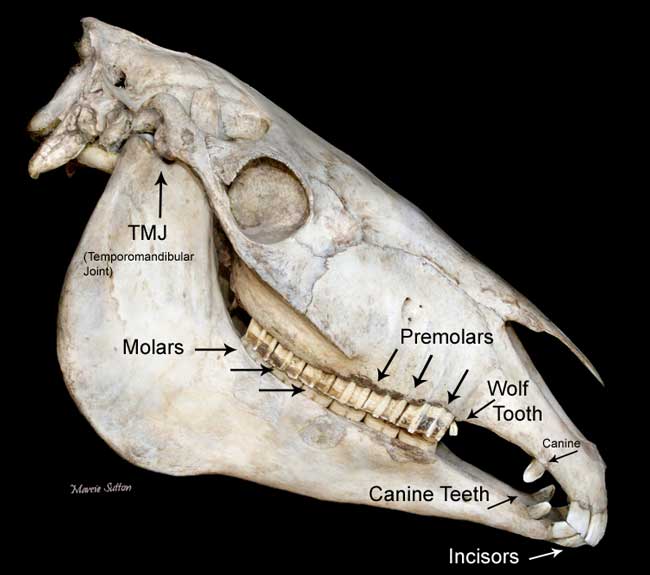
camelid- llama- 2 sharp incisors, 2 cannines anterior to cheek, border by diastema
antelope/gazelle =0 teeth on upper jaw
horse/mule picture= 6 normal incisors (2 missing on ours)
ARTIODACTYL HEAD ORNAMENTS
3diff types
horns pictured, pronghorn and antler
gazelle bears horns,

comprised of a conical bone core, covered by a layer of keratin (a resilient protein). Horns are typical of the bovids and the bison in the exhibit hall by the side exit of the museum); they are usually borne by both sexes, and are not shed.

The deer bears antlers.

Antlers are comprised of bone only. However, they are shed every year and regrown. They are only in males except in caribou/reindeer (Rangifer tarandus) where they occur in most females as well. When antlers first emerge they are covered in skin (the velvet); when as mating season begins, the skin is shed and the antler bone dies; it is actually dead bone while it is used, and shed at the end of mating season.
Finally, the pronghorn bears a special kind of horn,

in which the core is laterally compressed bone and the keratin covering is shed every year, pushed off by the new covering (so the bone is never uncovered). These horns are borne by both males and females.
Using spikes on your head as a weapon means banging your head a lot! What structural feature helps these artiodactyls (specifically the deer and gazelle) to reinforce the bones of the head and keep them holding together on impact? (Hint: for comparison, you might also look at how head bones are held together in the perissodactyls at the next station).
gazelle and mule/deer are v convoluted so bones are interlocked more tightly for strength than the pronghorn

PERISSODACTYLS AND PROCAVIIDS (HYRAXES)

bearing weight on the central digit of the foot, and by having a reduced, odd number of digits (3 or 1) present on the hind foot. Among living vertebrates they include only the horses, rhinos, and tapirs. They are much less diverse than artiodactyls (with only 17 living species). Horses are highly specialized runners, with their feet reduced to a single digit (the fetal burro shows this is the case even at early stages of development). Tapirs bear a small trunk on their faces – the signature of this feature on their skull is the highly recessed and enormous nostril.

In addition to being specialized as runners, horses are also specialized for eating highly abrasive vegetation, like grasses. Compare the teeth of the mule picutre and tapir – how do they differ? (Hint – the most important difference with regard to an abrasive diet might be suggested by the teeth of the upper jaw of the mule).

Tap: picture see root, know root bc enamel end
mule- v long teeth
Look at the teeth and jaws of the hyrax – carnivore or herbivore?

herbivore eventhough has caniniform canine like incisors
SIRENIANS (MANATEES AND DUGONGS)
Order Sirenis= two families: Dugongidae (dugongs) and Trichechidae (manatees). only mammalian marine herbivores
Manatees are an aquatic mammal found off the coast of Florida. The bones are very dense and massive, which are adaptations for overcoming the buoyant effects of water

What is the closest relative of sirenians?
elephants

Mammals exhibit at least 3 distinctive synapomorphies:(1) Hair(2) Mammary (milk producing) glands
(3) 2 new middle ear ossicles (tiny bones): the incus (anvil) and the malleus (hammer)

malleus from articular
incus from quadrate
stapes had them

salamander dissection
Many amphibians have complete atrial division resulting in a 3-chambered heart, but not in this species.

no externnal ear inner, lateral line system, external gills--have lungs and are able to perform gas exchange through their skin, but larval salamanders that are wholly aquatic rely on gills to draw oxygen from water, paedomorphosis (a case of the general phenomenon called “neoteny” that we described in the amphibian lab), in which juvenile traits (like gills) are retained in sexually mature adults.
neck short, limbs= ansestral state of tetrapod short to body, robust tail laterally compressed cloaca, homodont, no bony palate,4 type vertebrae, myomere
largest organ =liver
kindneys run long body
Rat dissection
Jaw opening muscles of mammals are highly derived compared to those of other tetrapods. The primary jaw opener is the digastric (which means “two bellies”). Immediately posterior to the masseter, the caudal belly of the digastric is exposed. This is connected by a short tendon to the cranial belly of the digastric
neck/limbs long, hair, no lateral line, anus, testes scrotum
single tooth bearing jaw= dentary, MAny kinds of teeth, secondary palate, brown fat= heat protection
largest= liver
2 kidney bean shapes
4 distinct heart chambers